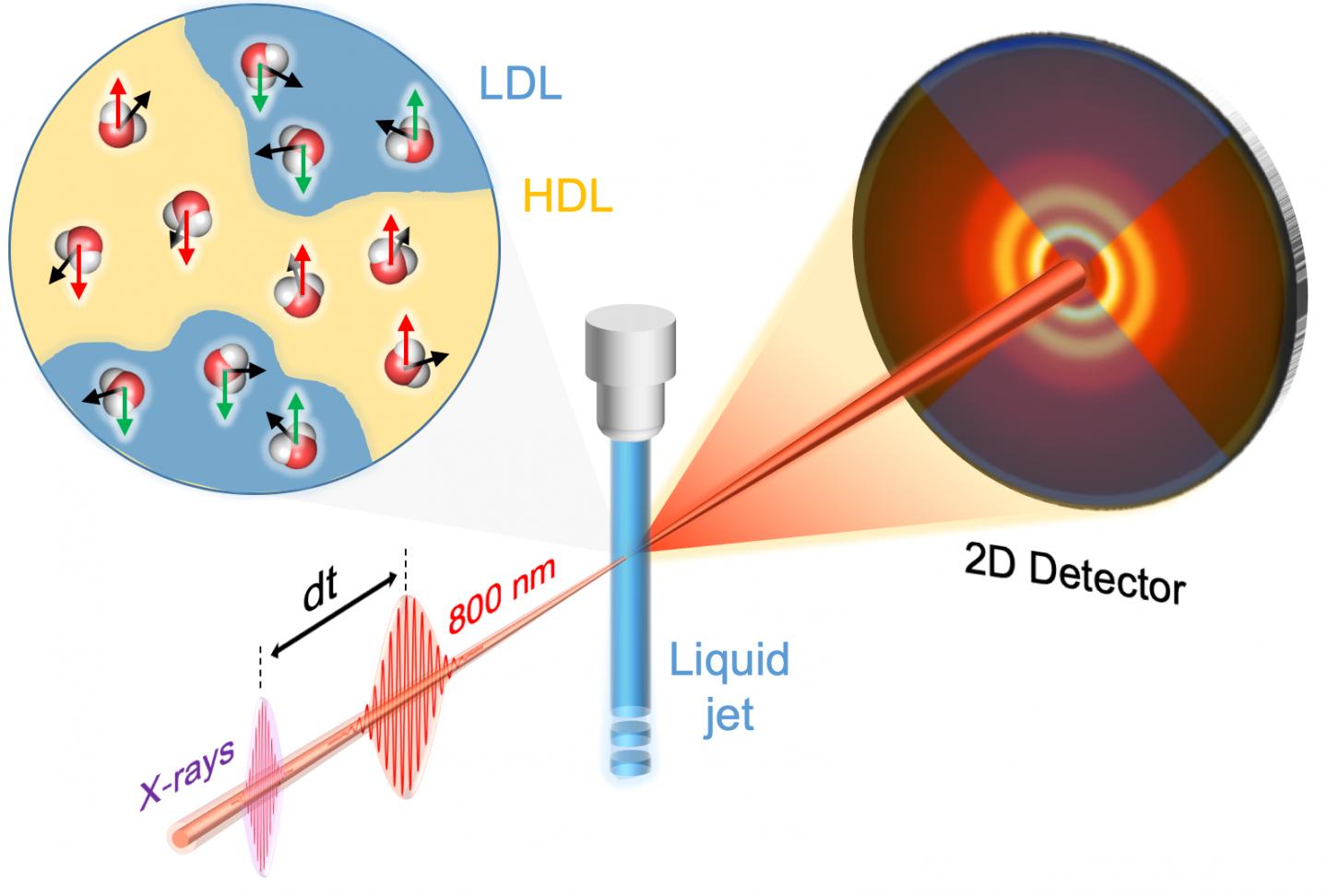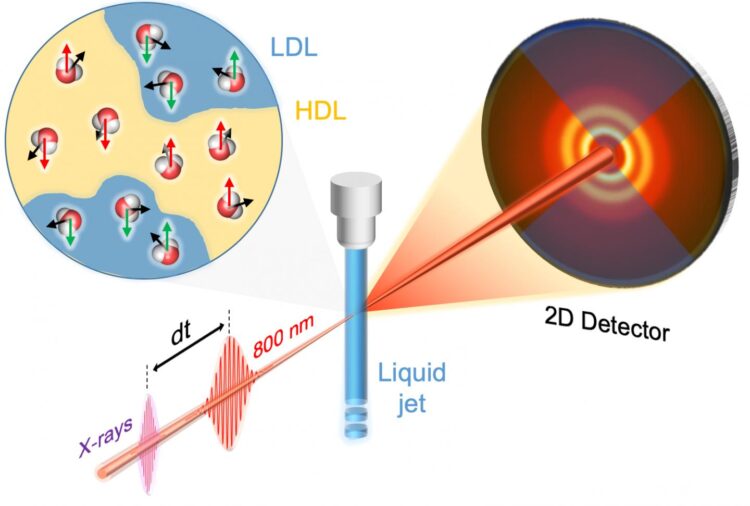
Credit: Fivos Perakis
Scientists at Stockholm University have discovered that water can exhibit a similar behavior like a liquid crystal when illuminated with laser light. This effect originates by the alignment of water molecules, which exhibit a mixture of low- and high-density domains that are more or less prone to alignment. The results, reported in Physical Review Letters on the 11th of August 2020, are based on a combination of experimental studies using X-ray lasers and molecular simulations.
Liquid crystals were considered a mere scientific curiosity when they were first discovered in 1888. Over 100 years later, they are one of the most widely used technologies, present in digital displays (LCDs) of watches, TVs and computer screens. Liquid crystals work by applying an electric field, which makes the neighboring molecules of a liquid align, in a way that resembles a crystal. Water too can be distorted towards a liquid crystal, when illuminated with laser light. It is known that the electric field of the laser can align the water molecules for less than a billionth of a second. Can this discovery have future technological applications?
An international team of researchers at the Physics Department of Stockholm University carried out experiments at Japan’s X-ray Free-electron laser SACLA and probed for the first time the dynamics of transiently oriented molecules using X-ray pulses. This technique, relies on aligning the molecules with a laser pulse (with wavelength λ = 800nm) and probing the alignment with X-ray pulses, which allow to see in real time the changes in the structure on a molecular level. By varying the time between the laser and the X-ray pulses, the researchers were able to resolve the aligned state, which lives only for 160 fs.
“It is known that the water molecules are aligned due to the polarization of the laser pulse” explains Kyung Hwan Kim, former researcher at Stockholm University and currently assistant professor at POSTECH University in Korea, “it is a unique capability however to be able to use X-ray lasers to see the molecular alignment in real time.”
“X-rays are perfect for probing molecules because their wavelength matches the molecular lengthscales” says Dr. Alexander Spa?h, former PhD student in Physics at Stockholm University, and currently being a postdoc at Stanford University. “I really enjoy having the opportunity to use state-of-the-art X-ray facilities to investigate fundamental questions that could have future technological applications.”
The experiments were well reproduced by molecular simulations, which gave an insight to the underlying alignment mechanism. By assuming that water behaves like a two-state liquid, consisting of high- and low-density liquid (HDL and LDL) domains, the researchers discovered that each domain shows a different tendency to align.
“Water molecules in the LDL regions have stronger hydrogen bond network, which makes the molecules easier to respond to the strong laser field” explains Anders Nilsson, professor in Chemical Physics at Stockholm University. “It would be fascinating to measure the lifetime of the molecular alignment in the supercooled regime, where everything is expected to slow down dramatically”.
“Being able to understand water on a molecular level by watching the changes of the hydrogen-bond network, can play a major role in biological activity” says Fivos Perakis, assistant professor in Physics at Stockholm University. “I am curious to see whether the observed alignment can lead to technological applications in the future, for example in connection to water cleaning and desalination”.
###
These studies were led by Stockholm University and involve a collaboration including the POSTECH, University of Venice, KTH Royal Institute of Technology in Stockholm, Berkeley University, Uppsala University, MIT, SLAC National Accelerator Laboratory, Japan Synchrotron Radiation Research Institute and the University of Tokyo.
The other participants from Stockholm University involved in the study are Harshad Pathak, Stefano Bonetti, Katrin Amann-Winkel, Daniel Mariedahl and Daniel Schlesinger.
Original article:
Read the study “Anisotropic x-ray scattering of transiently oriented water” by K.H.Kim et al. https:/
DOI: 10.1103/PhysRevLett.125.076002
Contact information:
Assistant Professor Fivos Perakis , [email protected], phone: ++46855378591
Assistant Professor Kyung Hwan Kim, [email protected]
Professor Anders Nilsson, [email protected]
Dr. Alexander Spa?h, [email protected]
Media Contact
Per Larsson
[email protected]
Related Journal Article
http://dx.





